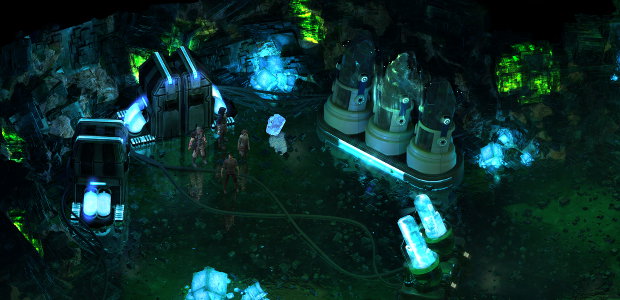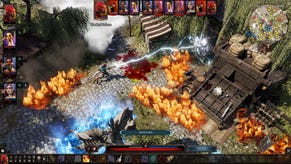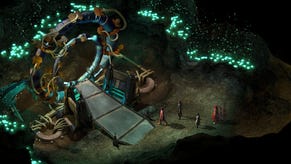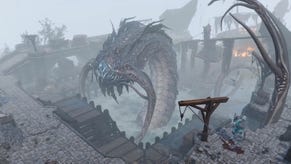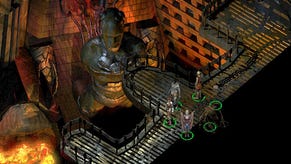Torment: Tides of Numenera addresses stretch goal cuts
Stretch as in 'on a rack'
With Torment: Tides of Numenera [official site] out later this month, developers inXile Entertainment have addressed complaints that some features billed in the RPG's crowdfunding campaign won't appear as expected. Some of these changes sound for the better, inXile following paths that they thought more Tormentous rather than ticking stretch goal boxes. Some, like ditching the Italian localisation, are more of a bummer. Crowdfunding campaign pitches are always broad "We'd like to make this sort of game; here's what we're currently thinking" ideas, likely to change and develop as the game takes shape, but stretch goals do feel different for being specific.
Over the past few weeks, fans and backers have poked and prodded, discovering that a variety of features listed as stretch goals - which were hit - won't be in Torment, or not quite as pitched. After addressing individual complaints here and there in forum posts, Torment creative lead Colin McComb last night posted an update on Kickstarter addressing the whole situation.
Some of the deviations from stretch goals, to be clear, sound good - changes which flowed naturally as the game came into focus. McComb explained:
"Building a game is not a straight line from start to finish. It’s not as simple as creating a design document, implementing it, and shipping it. It's an endlessly iterative process, one where ideas must be thought up, discussed, prototyped, iterated on again, and tested in game. The cycle repeats frequently. Sometimes, these ideas don’t work out the way you intended or just don't feel like they fit properly in the theme of the game."
For example, one location pitched in a stretch goal as another "major city", the Oasis of M'ra Jolios, ended up relegated to a smaller role as a different location was promoted to major hub status. McComb said:
"Though we fully intended that the Oasis would be our second city, story changes, plus our growing fascination with the Bloom, turned that location into our second major hub instead. In fact, the Bloom and surrounding areas are much larger than we originally discussed building for the Oasis. This didn't adversely affect the length of the game – we're still delivering a second major hub, and the Oasis will still appear in a smaller form. We feel this was the right move for the game creatively. It meant we could focus on a setting that felt darker and more distinctly Torment, and it improved the pacing immeasurably."
Sensible! As you learn what works best in the game, you focus on that.
A bit iffier is the decision to ditch several NPC companions who were spread across stretch goals, meaning the game will have six rather than nine. McComb explained:
"While we laid the groundwork for more, while building the game we realized that we had to make a tradeoff between companions with depth, or a larger amount. We chose to focus on the added richness and personality that you expect with a smaller group. The game’s scope increased considerably over what we originally set out to build, and we underestimated the amount of time and iteration it would take to make our companions as reactive and branching as they needed to be."
Again, that's them using their limited resources in a way they feel best, but I do think stretch goals warrant special attention.
Games often mobilise their fan base around stretch goals, getting them to spread the word and increase their own pledges to see specific features. Kickstarters fund broad ideas but stretch goals supposedly fund specifics. And fans do get invested in these, they do drive people to pledge to projects that are already funded. Even your level-headed cyberpal Alice has gotten excited over cool-sounding stretch goals. Here's the pitch for The Toy, a stretch goal companion attached to Torment's $2 million mark:
"The Toy is a changing ball of goo: Is it a pet, an abandoned toy, a dangerous weapon? Whatever it is, it responds to the way you treat it by changing its appearance and abilities to reflect what it perceives as your desires. Its ultimate secrets are... well, you'll have to find out."
That's more than inXile said about any companion (or all of them combined, even) in the original Kickstarter pitch. And The Toy does sound cool! And will not be in the game. After exciting fans with the idea, helping secure extra funding, inXile dropped it and didn't say anything.
It's a perennial crowdfunding problem: poor communication. I don't object to devs ditching or changing features as they see fit, but I think it's important to tell people who funded the development partially on the promise of their inclusion. InXile do acknowledge this. McComb says:
"We have always been major proponents of openness during development, but we did not communicate these changes earlier, and we should have done so sooner. For this, you have the entire team’s sincerest apologies."
If I'm honest, I'm glad certain features are cut. Another stretch goal was crafting and crafting is, of course, (almost) always terrible. McComb says that their crafting ideas "did not mesh well with the rest of the game's systems." He explained:
"Rather than adding an element that felt tacked-on (and worse, out of place for Torment), we repurposed those resources. We added more cyphers and artifacts to the game. We also added some other, more story-based elements to further flesh out equipment and items. That helped the items fit with the structure and style of the emerging game."
One big stinker of a cut feature is the Italian localisation, which wasn't even a stretch goal, just a base feature. McComb say it would be very expensive, and "both our backer numbers and the sales of our prior RPGs in Italy meant it was unlikely we'd be able to field the very high costs." He explains that they hadn't known the script would swell to over 1.2 million words. That just seems like poor planning. They are offering refunds to Italian backers who want them, but this comes after a long time of leaving them thinking they'd get an Italian translation. Poor planning, poor communication.
I half-wish crowdfunding campaigns would simply say "We'll use any extra money to try to make it better, maybe in this way!" Or "We'll accept extra money and keep on making it." A simple "Give us money and we'll use to try to make a cool video game!" I understand why devs don't do that, but committing to stretch goals can dilute a game with box-ticking features yet dropping them can lead to upset.
McComb acknowledges this:
"A lesson we've taken away since the Kickstarter campaign is to avoid being too specific in detailing early designs, locations, and characters – it's fun and exciting at the time for us and you, but..."
I think there's a disparity between how developers and we the public see crowdfunding, and we're probably in the wrong. We are very much backing broad ideas whose destinations are yet unknown but too often we see them as promises. The specificity of stretch goals blurs the line and encourages that thinking, fostering frustration and disappointment, but perhaps they draw enough money to be worth it.
An earlier version of this post said an Italian localisation was a stretch goal; it wasn't, it was part of the base pitch.





